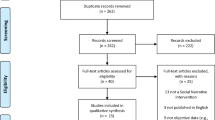Abstract
A retrospective evaluation of stories told to three Thematic Apperception Test (TAT) cards by children at risk isolated six characteristics that were associated with functioning six to 10 years later. The characteristics included lack of individual initiative, denial of mother-child relationships, denial of negative outcomes, and lack of autonomy. The TATs of children at risk (due to one parent's hospitalization for a psychotic illness) who subsequently suffered major decompensations themselves (requiring hospitalization or intensive outpatient therapy) could be discriminated from those of children at risk with apparently normal development. The TAT characteristics were independent of the level of adjustment at the time the TATs were administered, not related to the child's IQ, socioeconomic status, race, or other family characteristics, and moderately negatively correlated with story length.
Similar content being viewed by others
References
Murray HA:Thematic Apperception Test Manual. Cambridge, Massachusetts: Harvard University Press, 1943.
Alkire A, Brunse A, Houlihan J: Avoidance of nuclear family relationships in schizophrenia.J Clin Psychol 30:398–400, 1974.
Meyer R, Karon B: The schizophrenogenic mother concept and the TAT.Psychiatry 30:173–197, 1967.
Mitchell K: An analysis of the schizophrenogenic mother concept by means of the TAT.J Abnorm Psychol 73:571–574, 1968.
Nichols N: The relationship between degree of maternal pathogenicity and severity of ego impairment in schizophrenic offspring.Dissertation Abstracts International 31 (8-B):5003, 1971.
Leitch M, Schafer S: A study of the Thematic Apperception Tests of psychotic children.Am J Orthopsychiatry 17:337–342, 1947.
Jones FH: A 4-year follow-up of vulnerable adolescents.J Nerv Ment Dis 159:20–39, 1974.
Anthony EJ: The developmental precursors of adult schizophrenia.J Psychiatr Res 6(Suppl. 1):293–316, 1968.
Anthony EJ: A clinical evaluation of children with psychotic parents.Am J Psychiatry 126:177–184, 1969.
Hollingshead A: The two-factor index of social position. Unpublished manuscript, undated.
Worland J, Lander H, Hesselbrock V: Psychological assessment of clinical disturbance in children at risk for psychopathology.J Abnorm Psychol 1979. In press.
Maxwell AE:Analyzing qualitative data. New York: John Wiley and Sons, Inc., 1961.
Farina A, Dunham RM: Measurement of family relationships and their effects.Arch Gen Psychiatry 9:64–73, 1963.
Lefcourt MM, Steffy RA: Sex-linked censure expectancies in process and reactive schizophrenics.J Pers 34:366–380, 1966.
Magaro PA: Perceptual discrimination performance of schizophrenics as a function of censure, social class and premorbid adjustment.J Abnorm Psychol 72:415–420, 1967.
Silverman J: The problem of attention in research and theory of schizophrenia.Psychol Rev 71:352–379, 1964.
Author information
Authors and Affiliations
Rights and permissions
About this article
Cite this article
Shabad, P., Worland, J., Lander, H. et al. A retrospective analysis of the tats of children at risk who subsequently broke down. Child Psych Hum Dev 10, 49–59 (1979). https://doi.org/10.1007/BF01433637
Issue Date:
DOI: https://doi.org/10.1007/BF01433637




